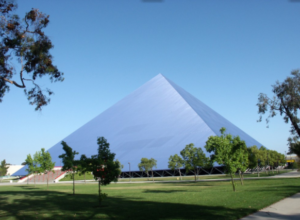
Feng Shui could be called “astrology for architecture.” and a very basic, essential branch of feng shui is called “Form School.” Studying the influence of shape and form can reveal how architecture plays a role in our health and well-being.
ROUND
Round or circular shapes invite energy to swirl around. This can be conducive to good conversation and a feeling or equality at a round table. On a larger scale, a round building can make the occupants un-focused and gossipy. An artist can handle being inside a round shape better than the average person.
SQUARE
The square or moderate rectangle is considered a balanced shape in feng shui theory. Square buildings and houses are also easier to diagnose, but it also makes sense just looking at the square to know that it will feel structurally strong and balanced.
TRIANGLE
The triangle actually represents the fire element, with its pointy, threatening edges. Triangular shaped buildings can cause the occupants to argue and be more aggressive. Energy boomerangs off the triangular walls, causing chaos and making that environment more accident-prone.
EXTREMELY LONG AND NARROW
Very narrow hall ways and rooms will tangibly restrict the flow of energy and occupants will sense the pressure. This is just a bad design that does not have a great remedy to compensate for it. It is like a restricted artery that blocks a healthful flow of air currents.
L-SHAPED STRUCTURE
Depending on how extreme the L-shape is, the area where the two parts meet will absorb a lot of pressure, like an elbow joint. It increases stress.
PYRAMID SHAPE
Even though the pyramid shape is associated with the ability to “preserve,” it is not an ideal shape for living beings to be in. I’ve never heard anyone say they feel comfortable at the Luxor Hotel in Las Vegas, as one example. The slanted ceilings and the point at the ceiling are considerable feng shui flaws.The image of the pyramid in this article is located at Cal State University, Long Beach (California).
U-SHAPE
If your house looks like a “U” with the open side facing the street, then it is said to have no “face.” The qi can collect and stagnate inside the U and it can imply a person who lives there with a hidden lifestyle. This is also true for houses with obscured front doors, not easily seen from the street, due to high hedges, walls, or other designs to keep the front door hidden.
When the “U” shape is reversed towards the back yard, this is the kind of house that has no backing or spine. This is the “sitting” side. The occupants may find it challenging to save money in this kind of house.
CEILINGS
The severely sloped ceiling will cause an uneven flow of qi from ceiling to floor. This uneven flow can cause sleep problems or lack of concentration. If the ceiling is flat, but just very high, this also can make a person feel expansive in a social setting, but harder to concentrate in a work environment. Unusually very low ceilings will pressurize occupants and also cause an irritation. Exposed beams are another problem.
These are just a few simple examples of how energy is manipulated by shape. The shapes can be large, such as with houses and buildings. Then on a small scale, our furnishings and decor will direct energy through the house.
The dimensions of a room and the location of doors and windows will influence the air flow pattern. Though it seems imperceptibly subtle, these are the characteristics of your environment, which can help or hinder the quality of your sleep as well as the communication/relationship dynamics of a household or work force.
Author: Kartar Diamond
Company: Feng Shui Solutions ®
From the Architecture & Design Blog Series
